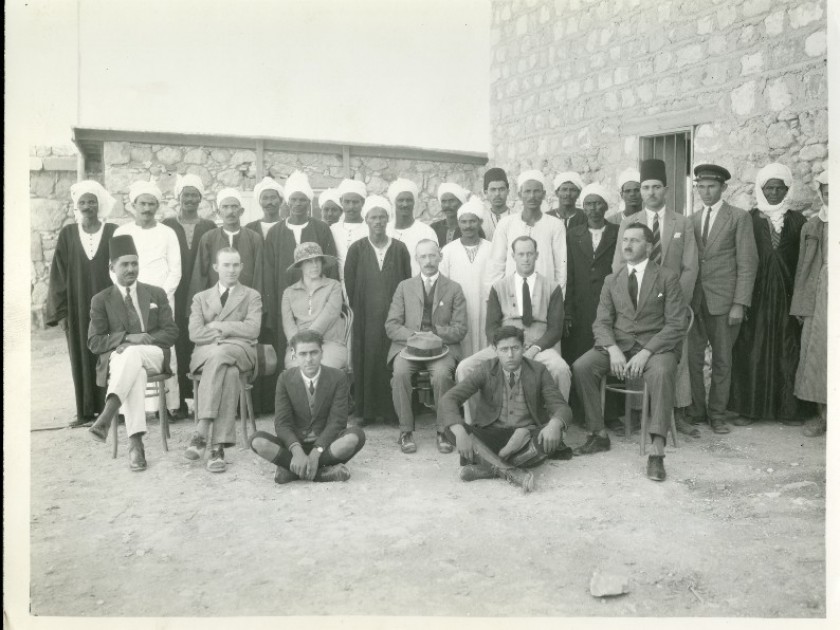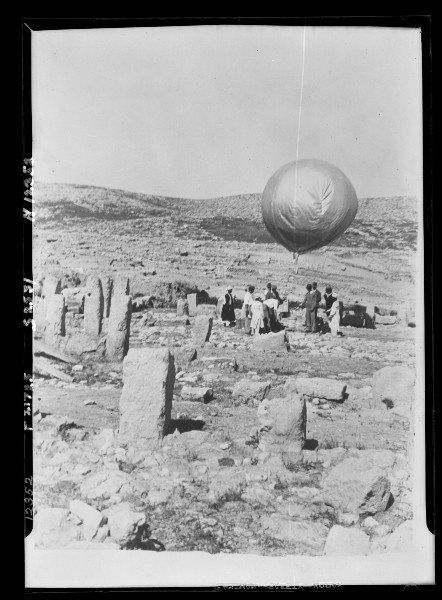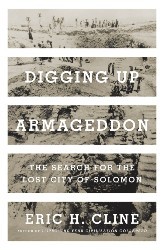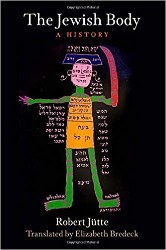
Courtesy of the Oriental Institute of the University of Chicago.
Few people today realize that Armageddon is a real place, but it certainly is. The very word “Armageddon” comes from “Har Megiddo” — Hebrew for the “mound” or “mountain” (har) of Megiddo. [1] By the Middle Ages, multiple nationalities, languages, and centuries had added an “n” and dropped the “h,” transforming “Har Megiddo” to “Harmageddon” and thence to “Armageddon.”
The ancient site of Megiddo, located now in the Jezreel Valley of modern Israel, is actually mentioned a dozen times in the Hebrew Bible, and in a multitude of other ancient texts, but it is especially well-known as the setting in the New Testament for the penultimate battle between the forces of good and the forces of evil. We are told in Revelation 16:16 that the two opposing armies will assemble “at the place that in Hebrew is called Armageddon.”
Megiddo has been at the center of biblical archaeology for more than a century. It is particular famous for discoveries such as “Solomon’s Stables” (which are probably not Solomon’s and might not be stables), as well as the water tunnel, the Megiddo ivories, the Sheshonq fragment, and so on.
Within the mound itself, we now know, are the remains of at least twenty ancient cities, built one on top of another over the course of nearly five thousand years, from about 5000 BCE to just before 300 BCE. The various excavators have given a Roman numeral to each one, I – XX, numbering them sequentially. Stratum I, at the very top, is the most recent, dating to the Persian period. Stratum XX, located just above the native bedrock, is the oldest settlement, dating to the Neolithic period. The strata in between date to the Copper, Bronze, and Iron Ages, including the time of the Canaanites and the Israelites.
The first person to excavate at the site was Gottlieb Schumacher, an American of German ancestry. His excavations from 1903 to 1905 were sponsored by the German Oriental Society and the German Society for the Exploration of Palestine. Twenty years later, in 1925, excavators from the Oriental Institute at the University of Chicago arrived at the site, determined to find Solomon’s city. They stayed for fifteen excavation seasons, exposing most of what can now be seen at the site today, and halting only because of World War II.
Despite consisting largely of architects and geologists retrained as archaeologists and pottery specialists, and notwithstanding changes in personnel on an almost yearly basis, the team from Chicago was among the best to excavate in the Middle East at the time. They retrieved the entire chronological history of Megiddo, from the Neolithic period to the Persian era, and noted the later Roman graves and adjacent remains as well. Along the way, they incorporated cutting-edge innovations and techniques, including balloon photography, vertical excavation, and the use of the Munsell color system for describing soil color. Their discoveries and innovations still resonate throughout biblical archaeology.
Their discoveries and innovations still resonate throughout biblical archaeology.

Courtesy of the Oriental Institute of the University of Chicago.
They were followed in the 1960s and 1970s by a team led by Yigael Yadin from the Hebrew University of Jerusalem and then, from 1994 until the present, by a team led primarily by Israel Finkelstein and David Ussisskin from Tel Aviv University. I was part of that fourth excavation team, working at the site from 1994 and rising through the ranks from volunteer to co-director until I retired from the dig in 2014.
I started working on Digging Up Armageddon back in the spring of 2015. It began life as a book about the archaeology of Megiddo meant for the general public, going level by level and building by building. But then I found out that a colleague of mine was working on the exact same topic, which happens more often than one might imagine. Fortunately, by that point I had found another angle, which emphasized the archaeologists as much as the archaeology.
I happened to go to the archives at the Oriental Institute of the University of Chicago at a very early point in my research and I discovered a treasure trove of personal papers there; a lot more than I ever expected. I was pretty sure that there were going to be notes about the levels and the stratigraphy and the various archaeological remains written by the three successive field directors: first Clarence Fisher, then Philip Longstaffe Ord Guy (more usually referred to as “PLO” Guy, an acronym which did not have the meaning back then as it does now), and finally Gordon Loud, all of whom had been sent to Megiddo by James Henry Breasted, the Director of the Oriental Institute. And indeed, there were. However, there were also letters and telegrams and diaries and notebooks and photographs from the other members of the staff as well.
One of the first things that I found was a cable that PLO Guy sent to Breasted in 1928, on the day that they found what he thought were Solomon’s stables, in which he literally quotes chapter and verse from the Hebrew Bible: “FIRST KINGS NINE FIFTEEN TO NINETEEN AND TEN TWENTYSIX STOP STRATUM FOUR APPARENTLY CORRESPONDS STOP BELIEVE HAVE FOUND SOLOMON’S STABLES.”
Considering that he had been waiting nearly three years for such a discovery, Breasted demonstrated remarkable restraint, because the cable which he sent back in reply that very same day consisted of a single word: “CONGRATULATIONS.”
And then I found out that the Rockefeller archives in Sleepy Hollow, NY, had letters that had been sent back and forth between Breasted and John D. Rockefeller, Jr., who financed the dig. There were also other items there, including Rockefeller’s travel diary, with an entry for the day that he visited Megiddo in 1929. “Friday, March 8” — Left 9 [a.m.] drove to the Oriental Institute of Chicago house at Megiddo. Mr. Guy in charge. Mr. Noble the English road engineer and wife also there. Saw excavation of Solomon’s stables. Left after lunch over same new road to highway near Haifa then back through Nazareth and on three-quarters of an hour to Tiberias on Sea of Galilee.” That was it; no other comments, notes, or reaction from the man who had been funding the entire enterprise to the tune of what would now be the equivalent of several million dollars.
I went on line to Ancestry.com and found living descendants of the team members, a few of whom I was able to contact. Some had additional photographs, letters, and diaries that had been kept in the family and which they shared with me.
As a whole, the scholarly publications by the Chicago excavators present their final thoughts on the results of their excavations. The books and articles that they published are still used, and debated, by archaeologists working in the region today. However, these provide only a small window into the daily activities of the team members and the stories behind their discoveries.
However, these provide only a small window into the daily activities of the team members and the stories behind their discoveries.
Fortunately, the treasure trove of other writings that they left behind — more than three decades’ worth of letters, cablegrams, cards, and notes exchanged by the participants, as well as the diaries that they kept allowed me to better understand and discuss these team members as real people in the context of their times, with hopes, fears, dreams, problems, ambitions, and desires, rather than simply being names on the spines of books or in bland lists of participants, which is what they had been to me previously.
For instance, Guy — the second field director — was married to Yemima Ben-Yehuda, whom he fondly referred to as “Jimmie” in his letters. They had wed in 1925, after the death of her father, Eliezer Ben-Yehuda, the well-known scholar primarily responsible for the revival of Hebrew as a spoken modern language. With this union, which brought him into the upper echelons of the Yishuv (the Jewish community), Guy became firmly entrenched in Zionist circles, even though he himself was not Jewish.
In working through all of these archival materials, I also realized that they provide us with a glimpse behind the scenes, a peek at the internal workings of the dig, playing out against the backdrop of the Great Depression in the United States, as well as the growing troubles and tensions in British Mandate Palestine between the two world wars. In addition, we also get a taste of what the early years of biblical archaeology were like, including the backstory of how they actually did the archaeology, and the tools and techniques that they used at the time; in some ways, it is a far cry from what we do and use today, while in other ways it has not changed at all.
The story of the Megiddo excavators includes intrigues, infighting, romance, and dogged perseverance, as well as the details underlying the drastic changes in staff and directors, before the digging came to an abrupt and unexpected end because of World War II. But even there the story doesn’t end, because during the 1948 Israeli War of Independence and the months immediately following, there was a battle fought at the ancient site on May 30th through the 31st; the dig house was looted sometime between late June and late July; and a fire destroyed most of the house and other buildings in mid-October. In the end, after a long investigation, the Israeli government paid the equivalent of nearly half a million dollars (in today’s money) in order to avoid a huge public scandal. A few years later, the University of Chicago sold both the site and the dig house to the government (specifically the Israeli Department of Antiquities and Museums) in January 1955 for the nominal sum of “One Dollar ($1.00).” And with that, the Chicago excavations at Megiddo officially ended, three decades after the first team members had arrived at the site in 1925.
[1] The following is excerpted from Digging Up Armageddon: The Search for the Lost City of Solomon (Princeton University Press, 2020). It is presented here without footnotes or references, all of which can be found in the published book. Archival material and quotations are reproduced by permission of the Oriental Institute at the University of Chicago, the Israel Antiquity Authority, and the Rockefeller Archive Center in Sleepy Hollow, New York, as described in greater detail in the book.
Eric H. Cline is professor of classics and anthropology and director of the Capitol Archaeological Institute at George Washington University. His many books include Three Stones Make a Wall: The Story of Archaeology and 1177 B.C.: The Year Civilization Collapsed (both Princeton). He lives in Rockville, Maryland.



